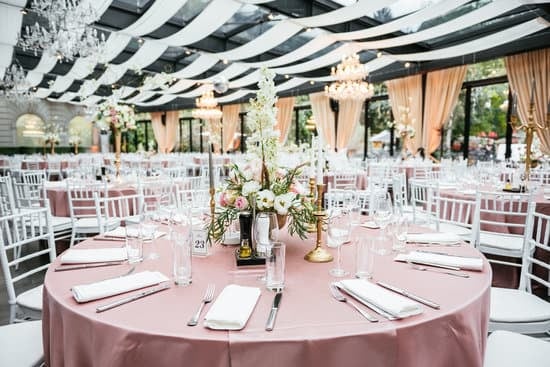Planning a wedding is an exciting and momentous occasion, filled with joy and anticipation. One of the most important aspects of this special day is the wedding ceremony itself.
The structure of the ceremony sets the tone for the entire event, creating a beautiful and meaningful experience for both the couple and their guests. In this blog post, we will explore the significance of structuring a wedding ceremony and provide valuable insights and tips on how to create a seamless and memorable occasion.
The basics of a wedding ceremony are crucial in creating a well-structured and harmonious event. From the processional to the recessional, each element plays an essential role in shaping the overall experience. Furthermore, choosing the right format for your ceremony, whether it be religious, secular, traditional or personalized, can greatly impact the atmosphere and reflect the values and beliefs of the couple.
In addition to discussing essential elements and different formats, we will also delve into creating a timeline for your ceremony, understanding the officiant’s role, incorporating personal touches, selecting music and readings that resonate with you as a couple, coordinating vendors successfully on your big day – all leading up to offering final thoughts on crafting an unforgettable wedding ceremony that reflects your love story.
The Basics
When planning a wedding, one of the most important aspects to consider is how to structure the ceremony itself. A well-structured wedding ceremony sets the tone for the entire event and ensures that everything runs smoothly on the big day. In this section, we will discuss the essential elements of a wedding ceremony and how to incorporate them effectively.
Here are some key elements that are essential in structuring a wedding ceremony:
- Processional: The processional marks the beginning of the ceremony and involves the entrance of the wedding party, including the bridesmaids, groomsmen, ring bearer, flower girl, and finally, the bride herself. This is an important part of setting the stage for the rest of the ceremony.
- Vows: The exchanging of vows is often considered the heart of the wedding ceremony. Whether couples choose traditional vows or write their own, this moment should be meaningful and personal.
- Ring Exchange: The exchange of rings symbolizes the couple’s commitment to each other and is a significant part of any wedding ceremony.
- Recessional: The recessional marks the conclusion of the ceremony and involves the exit of the newlywed couple followed by their wedding party. This is a joyful and celebratory moment that transitions seamlessly into the post-ceremony festivities.
It’s important to carefully plan and structure these elements to create a cohesive and meaningful ceremony that reflects the couple’s unique love story.
In addition to these essentials, couples may also want to consider incorporating cultural traditions or special rituals that hold personal significance. Doing so can add depth and meaning to their wedding ceremony while honoring their heritage and family customs. Ultimately, structuring a wedding ceremony involves thoughtful planning, attention to detail, and a desire to create a memorable experience for both the couple and their guests.
Choosing a Format
When it comes to structuring a wedding ceremony, one of the most important decisions to make is the format. The format of the ceremony sets the tone for the entire event and reflects the values and beliefs of the couple. There are several different formats to consider, each with its own unique elements and traditions.
Religious ceremonies are often rooted in specific faith traditions and may include rituals such as prayers, blessings, or religious readings. These ceremonies are led by a religious officiant, such as a priest, rabbi, or minister. In contrast, secular ceremonies are non-religious and focus on celebrating the love between the couple without religious elements.
Traditional ceremonies often follow a specific order of events that has been passed down through generations. These ceremonies may include customs such as unity candle lighting or handfasting rituals. On the other hand, personalized ceremonies allow couples to create their own unique structure with personal vows, special readings, or cultural traditions that hold meaning for them.
No matter which format is chosen, it’s essential to ensure that the ceremony reflects the values and beliefs of the couple and creates a meaningful experience for everyone involved. By carefully selecting a format that resonates with both partners and incorporating personal touches throughout the ceremony, couples can create an event that truly reflects their love and commitment.
| Format | Description |
|---|---|
| Religious | Ceremonies rooted in specific faith traditions with religious officiants. |
| Secular | Non-religious ceremonies focused on celebrating love without religious elements. |
| Traditional | Ceremonies following specific order with customary rituals passed down through generations. |
| Personalized | Create unique structures with personal vows, special readings or cultural traditions. |
Creating a Timeline
When it comes to planning a wedding ceremony, creating a detailed timeline is essential for ensuring that the event runs smoothly and all elements are executed seamlessly. A well-thought-out timeline not only keeps things organized but also allows for flexibility and adaptation on the big day. Here’s how you can structure a timeline for your wedding ceremony to ensure everything falls into place perfectly.
Pre-Ceremony
The pre-ceremony phase sets the stage for the rest of the event. This includes the arrival of guests, seating arrangements, and any prelude music playing in the background as attendees take their seats. It’s important to factor in ample time for guests to arrive and get settled before the ceremony begins, as well as any special instructions or activities that need to be communicated.
Ceremony Processional
The processional marks the official start of the wedding ceremony and involves the entrance of key individuals such as the bridal party, groomsmen, bridesmaids, ring bearer, flower girl, and lastly, the entrance of the bride. It’s crucial to have a precise order of entry and enough distance between each person or group for a visually impactful procession.
Key Ceremony Elements
This portion of the timeline encompasses major components like exchanging vows, exchanging rings, unity ceremonies (if applicable), and any special readings or musical interludes. It’s essential to allocate sufficient time for each of these elements while maintaining a comfortable pace that keeps guests engaged without feeling rushed.
Ceremony Recessional
The recessional signifies the conclusion of the wedding ceremony and typically involves an orderly exit of everyone involved in reverse order from how they entered. It’s important to ensure that this part happens seamlessly and efficiently to maintain an organized flow.
By incorporating these elements into a detailed timeline, couples can navigate how to structure a wedding ceremony with ease, from start to finish. This ensures that every moment is cherished and flows naturally without any hiccups along the way.
Officiant’s Role
The choice of an officiant is a crucial element in structuring a wedding ceremony. Regardless of whether the ceremony is religious, secular, traditional, or personalized, the officiant plays a key role in ensuring that the ceremony runs smoothly and reflects the couple’s values and beliefs. How do you structure a wedding ceremony with the help of an officiant?
First and foremost, it’s essential to discuss the responsibilities of the officiant when planning the ceremony. This includes their role in guiding the couple through the process of creating a personalized ceremony script that incorporates their unique love story, values, and cultural backgrounds. The officiant also helps in obtaining any necessary documentation for legal marriage requirements and ensures that all legal aspects are addressed during the ceremony.
Working closely with the officiant is crucial to structuring a memorable and meaningful wedding ceremony. Couples should schedule regular meetings with their officiant to brainstorm ideas, review drafts of the ceremony script, and make any necessary adjustments. It’s important to communicate openly about your vision for the ceremony and be receptive to guidance from the officiant based on their expertise and experience.
| Officiant’s Responsibilities | Working With Your Officiant |
|---|---|
| Guiding couple through creating personalized script | Schedule regular meetings to discuss ideas |
| Ensuring legal marriage requirements are met | Be open about your vision for the ceremony |
Incorporating Personal Touches
When it comes to planning a wedding ceremony, incorporating personal touches can make the event even more special and meaningful. From readings and rituals to cultural traditions, there are countless ways to infuse your unique personalities and love story into the ceremony. Here are some creative ideas for adding personal touches to your wedding ceremony:
- Readings: Consider including readings or poetry that hold special meaning for you as a couple. This could be a favorite poem, an excerpt from a beloved book, or even lyrics from a song that is significant to your relationship.
- Rituals: Incorporating rituals into your wedding ceremony can be a beautiful way to symbolize your union. Whether it’s a unity candle lighting, handfasting ceremony, or sand pouring ritual, these symbolic acts can add depth and significance to the occasion.
- Cultural Traditions: Embrace your heritage by including cultural traditions in your wedding ceremony. This could involve incorporating traditional clothing, music, dance, or customs that reflect your background and family history.
Adding these personal elements to your wedding ceremony not only makes the event more memorable but also creates a deep sense of connection between you and your partner. These unique touches will leave a lasting impression on both you and your guests.
By infusing your wedding ceremony with personal touches such as meaningful readings, symbolic rituals, and cultural traditions, you can create an unforgettable experience that truly reflects who you are as individuals and as a couple. These elements will not only add depth and significance to the ceremony but also create lasting memories for you and your guests on this special day.
Music and Readings
The Role of Music
Music plays a significant role in setting the tone and atmosphere of a wedding ceremony. From the processional to the recessional, music enhances the emotional impact of each moment. When choosing music for your ceremony, consider pieces that are meaningful to you as a couple and reflect the mood you want to create. Whether you opt for traditional songs or modern tunes, the right music can make your ceremony truly unforgettable.
Selecting Readings
Readings are another way to add personal meaning to your wedding ceremony. Whether it’s a religious passage, a poem, or an excerpt from a favorite book, readings can convey the love, values, and hopes that you share as a couple. When selecting readings, think about passages that resonate with both of you and capture the spirit of your relationship. Consider involving family members or close friends as readers for an even more special touch.
Tips for Choosing Music and Readings
When choosing music and readings for your wedding ceremony, it’s essential to consider the overall theme and feel of your event. Think about whether you want to keep things classic and timeless or infuse some modern twists. Remember that both music and readings should reflect your unique personalities as individuals and as a couple. Additionally, be sure to communicate with your officiant or wedding planner about any specific guidelines or restrictions that may apply to your choices.
Whether you’re envisioning a romantic classical piece or a contemporary love song, selecting the perfect musical accompaniment for each stage of your ceremony is an essential part of creating an unforgettable event”.
Rehearsal and Coordination
A wedding ceremony is a significant event in a couple’s life, and it’s essential to ensure that everything runs smoothly on the big day. One crucial aspect of achieving this is the rehearsal and coordination of the ceremony.
A rehearsal allows the wedding party to familiarize themselves with their roles, understand the sequence of events, and iron out any potential hiccups before the actual ceremony. It also provides an opportunity for vendors, such as photographers and musicians, to coordinate their actions and anticipate any logistical issues that may arise.
When it comes to coordinating the wedding party and vendors on the day of the ceremony, communication is key. The officiant, wedding planner or coordinator, and key members of the wedding party should be aware of their responsibilities and know how to communicate with each other effectively. This can involve creating a detailed timeline for the day, establishing points of contact for different vendors, and ensuring that everyone is informed about any last-minute changes or updates.
In addition to communication, organization plays a vital role in coordinating a wedding ceremony. Assigning specific tasks to trusted individuals within the wedding party can help streamline coordination efforts.
For example, having a point person responsible for communicating with vendors, another for overseeing seating arrangements, and another for assisting with any unexpected issues can help ensure that everything runs smoothly on the day of the ceremony. With thorough preparation and effective coordination, couples can look forward to a beautiful and stress-free wedding ceremony.
Conclusion
In conclusion, structuring a wedding ceremony is an essential part of creating a meaningful and memorable event for you and your partner. By carefully planning each element, from the processional to the recessional, you can ensure that your ceremony reflects your unique relationship and sets the tone for the rest of your wedding day.
Whether you choose a religious, secular, traditional, or personalized format, it’s important to consider how each aspect of the ceremony contributes to the overall experience for both you and your guests.
Additionally, working closely with your officiant is crucial in crafting a ceremony that truly speaks to who you are as a couple. Their guidance and expertise can help you navigate the different elements of the ceremony and ensure that everything runs smoothly on the big day. Furthermore, incorporating personal touches such as readings, rituals, and cultural traditions can add depth and meaning to your ceremony, making it even more special for you and your loved ones.
As you move forward with planning your wedding ceremony, remember to take time for a rehearsal and coordination session to iron out any kinks and ensure that everyone involved knows their roles. Lastly, choosing the perfect music and readings can bring an extra layer of emotion and beauty to your ceremony. With careful consideration of all these elements, you can create a wedding ceremony that is not only memorable but also truly reflective of your love story.
Frequently Asked Questions
How Are Wedding Ceremonies Structured?
Wedding ceremonies are typically structured to include an opening, vows, exchange of rings, unity ceremony, readings or music, pronouncement, and the kiss. The structure can vary depending on cultural or religious traditions.
What Is the Normal Order of a Wedding Ceremony?
The normal order of a wedding ceremony usually begins with the processional, followed by welcoming remarks, a reading or song, exchange of vows and rings, any unity ritual like lighting a candle or pouring sand, pronouncement of marriage, and the recessional.
How Do You Format a Wedding Ceremony?
When formatting a wedding ceremony, it’s important to start with an outline of the order of events. This can be customized to fit the couple’s preferences and any cultural or religious requirements. Including personal touches like readings or rituals makes it unique and special for the couple.

I have been involved in marriages for over 20 years helping couples and singles understand more about them.





